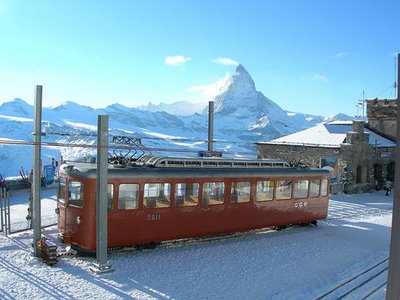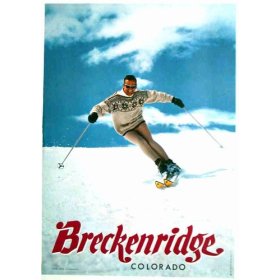I wrote this in 2003 after visiting Zermatt with Waldo. I figured this would be a good thing to revisit vicariously. These pictures are not mine; they are from Flickr.-------------
I've been a long time occassional lurker/searcher of r.s.a. and can't recall ever contributing any reports. Hopefully this should make up a little for all that I've learned from this group.
An old college friend and I had long planned but had kept postponing a trip to ski in
Zermatt, Switzerland for several years. Things always kept coming up but after 9/11 I kind of resolved to start doing the things that I had dreamed about but never gotten around to. After some research we decided on visiting the last week of February 03 due to the theoretical combination of long days, good snow, and non school holidays. We had chosen a time based off the US school calendar unfortunately it did appear to be a time when Swiss kids were out of school and families were vacationing in Zermatt.
Traveling there was fairly straight forward but had a few minor kinks. I flew direct from NYC to Geneva via Swiss Air who are generally competent. My buddy flew via Air France with a switch in Paris; this caused Air France to lose his skis on both legs of the journey. From Geneva most US packagers put you on the Swiss rail service to Zermatt which involves getting on a train at the Airport (!) and riding for a few hours to a village called Visp. Here you switch to a cog train that crawls up the mountain. Dealing with your luggage during this process is annoying but there is a certain charm to the train ride. The train ride ends in the village of Zermatt where you enter in the center of the village. The town is entirely internal combustion engine free so curious little electric carts [a little larger & faster than golf carts] whizz around town carrying people and goods. Most people at this time would wisely call their hotel and request a lift, or hire a taxi if they were staying in an apartment/condo complex. Foolishly we did neither and straggled a few blocks to the hotel we had reservations at, the
Mirabeau.
Upon attempting to check in we discovered they didn't have any space for us, but they arranged at no charge for us to be upgraded to a suite at a much nicer hotel, the
Grand Schonegg, not far away. We were dropped off there by the little carts and got a large suite. We were generally impressed by this hotel which had an entrance on the street perhaps 40-50 feet below the hill it is perched on. You had to enter the hotel via a long tunnel and then take an elevator up into the bowels of the building. The Swiss certainly have great skill in digging into these mountain environments and this kind of arrangement appeared to be commonplace for hillside properties. That first evening we got our gear put away, ate some dinner, and sulked about Air France.
------
The next day I rented skis, a pair of "titanium powered" Volkl P50s, and we proceeded to head to one of the ski areas. At this point it should be noted that the village of Zermatt existed long before the skiing did so there is a fair amount of "schlepping" that has to be done before you are skiing. There are, broadly speaking, 3 main ski areas surrounding the village. Each has its own style, terrain, and most importantly access. They are called
Rothorn,
Gornergrat, and
Klein Matterhorn. This first day of skiing we decided to head up to Gornergrat based off of our hoteliers suggestion.

This area is accessed by taking an old fashioned cog/electric train up from the village to the moutain top. At the top of the mountain the ski runs are serviced by a combination of T-bars, the same railroad, and the odd cable car that goes even higher. This area is a delight for intermediate level skiiers, like myself, and is largely well pitched with wide runs covered by portable snowmaking guns. There are plans to install chairlifts here but for now its generally served by the T-bars. For a US skiier we found these annoying as we didn't get a chance to really rest after a run when using these. When we saw the train pulling in we would hop on that to get a breather for the next run. We spent the whole day playing here and had lunch at one of the numerous on mountain cafes. Due to the dollars decline, and Zermatts general priciness, the cafeteria food was a bit expensive for our tastes. At the end of the day we skiied down the mountain to a much lower train station and hitched that home. In general I would say that doing that is a waste of time and energy. The lower mountain "runs" are annoying and get too crowded and cut up by the end of the day. We didn't realize how the train schedule worked so that first time down we ended up waiting 20 min for a train at
Landtunnel.
The next day we grabbed our passports [unnecessarily it turned out] and headed to the Klein Matterhorn area. The goal was to ski in
Cervinia, an Italian ski resort on the other side of the Matterhorn. We took a gondola up to
Trockener Steg and from there some T-bars & J-bars to the
Theodulpass, which separates Switzerland from Italy. From here there is lovely long and well pitched run all the way down the Italian village of Cervinia. The top part of this run has enough pitch to it that beginners would be uncomfortable; strong intermediates should be able to handle it although its likely to be the first run of the day for them. We skiied down 5500 feet into the village and thoroughly enjoyed ourselves. The snow in Cervinia seemed to be a tad softer than what we'd skiied in Gornergrat but I'm not sure if that's usual/normal; neither area had had fresh snow in a while. We then went up to the mid mountain area of Cervinia,
Plan Maison, and happily skiied this area the rest of the day. It is an intermediate skiiers paradise - wide runs, nice pitches, a few express lifts, and a lot of charm. The canteens here are also much more fairly priced than in Switzerland due to their usage of the Euro. After several hours of this we hopped on two cable cars to the Theodulpass and skiied back down to Trockener Steg where we took a number of cable cars back to the village. The picture below is of the Plain Maison area of Cervinia.

The next day we took a curious underground train, a funicular called
Sunnega, to the Rothorn ski area. This area feels much more modern than the rest of the area as they have lots of high speed lifts, gondolas, cable cars, and funiculars. I do not recall seeing any of the dreaded T-bars. There is a good amount of high quality cruising terrain here and I enjoyed some of the runs 4 or 5 times. Although I didn't ski it, there is also a steep groomed trail with snowmaking that seems to be a signature run for the area. It's called, rather unexcitingly, 1a. A trail like this in the Northeast would have some catchy name like TerminalVelocity or Mach10. There are some annoying runouts at the end of the less steeply pitched trails but those are kind of impossible to avoid. At least those long looping runouts in this area tend to be wide and have snowmaking. The upper part of the moutain is serviced by a cable car and has a fine area for all abilities on one face: steep stuff, steep groomed runs, and milder wider trails covered by snowmaking. These all feed into a lift served area. Adventurous souls can take a long catwalk all the way back to the village. It is surprisingly tiring and not recommended unless you are staying off that trail, or more wisely, stop at some of the numerous watering holes along the way. We did it once and learned our lesson.

The next day was spent in the Klein Matterhorn area. However the 3 perfect days of sunshine and 40F weather we had enjoyed previously came to an end. It was fairly windy and the lifts/cable cars were turned off at numerous times. This had the effect of creating large lift lines for the areas that could still serve skiiers. We skiied a little in the
Furgg area but I was generally frustrated by this whole set of circumstances, as well as being leg weary and hungover, so I didn't ski much and went back home around 2-3pm. My buddy was more motivated than I and spent more time skiing the groomed snowmaking runs off Furgg. At the end of the day he took, again, one of those long run out ski trails back into the village. He's a better skiier than I and reported that this trail was particularly annoying at the end of a long, windy tiring ski day as it had the triple crown of crowds, ice, and bumps. I avoided saying "I told you so". I didn't get a good sense for the Klein Matterhorn part of the moutain but it looks like the better skiiers would enjoy this more than I did. The views from this area, like all the others, are amazing as you can ski right in the shadow of the stunning 14000 ft Matterhorn moutain.

The next day we went back to the Italian side of the mountain to ski the
Valtourneche valley part of Cervinia. This area feels like a separate area in some ways as its served older, slower lifts and T-bars. However the terrain is great for cruising, the snow was softer than at other parts, and the crowds were very few. We had a happy day skiing this area and enjoying the long well cut cruising trails. Eventually we had to tack back up the mountain and make our way to the gondola to get us back to Switzerland. This was a day I enjoyed although my friend might have found the terrain to be a little flatter than his tastes preferred.
For our last and final day of the six day ski week we decided to spend the morning revisiting Rothhorn and then take a cable car across a valley to end up at the Gornergrat area while avoiding the train ride up. Despite some initial confusion we were eventually able to figure out how to do this and we then spent our last afternoon gently unwinding on the big cruisers and small groomed steeps of this area. After catching some late afternoon rays on the deck of the cafe there I got the train back to the village with sadness in my heart and lactic acid in my legs.
----
The village of Zermatt is one of the most beautiful and charming places I've ever stayed in. Its a pedestrian village with lots of nooks and crannies and tiny side streets. There is shopping galore as well as bars, clubs, restaurants etc. Of course due the difficulty of getting goods into the town [it all has to come by the one rail line], the strength of the Swiss Franc, and the general resort town price inflation, food and drink are expensive in this town for Americans. Strangely there are a lot of grocery stores in town where food and drink are not only less costly than eating out [as would be expected] but are
cheap in an absolute sense. For example at one bar we went to a 10 oz beer was 6 CHF...a one liter bottle of the same beer in a grocery store there was 1.5 CHF. The price spread was bizarre to me [1 USD ~ 1.30 CHF]
In the middle of the village there is a beautiful old church with a graveyard in front of it. This is Zermatt's hallowed ground, where her climbers -- often young foreign males -- are buried. The gravestones often have pickaxes and notations of how the moutaineers died [e.g. Lost on the descent from Hornli ridge, 1972]. Contrary to what you would think, its not a chilling place but rather uplifting that this mountain town would find a last resting place, with honour, for these kindred spirits who came from afar to test their mettle at the Matterhorn.

Overall it was a trip of a lifetime, something never to be forgotten, and its something to consider for those who might have to travel with people who need more than just skiing as the sole vacation event.
Pros: charming village, skiing to Italy, enough terrain for a week, wacky lifts/gondolas/funiculars etc, food in our Grand Hotel, train ride up there
Cons: cost, T-bars, schlepping everywhere to ski, price of beer, train ride up there.
AKR













